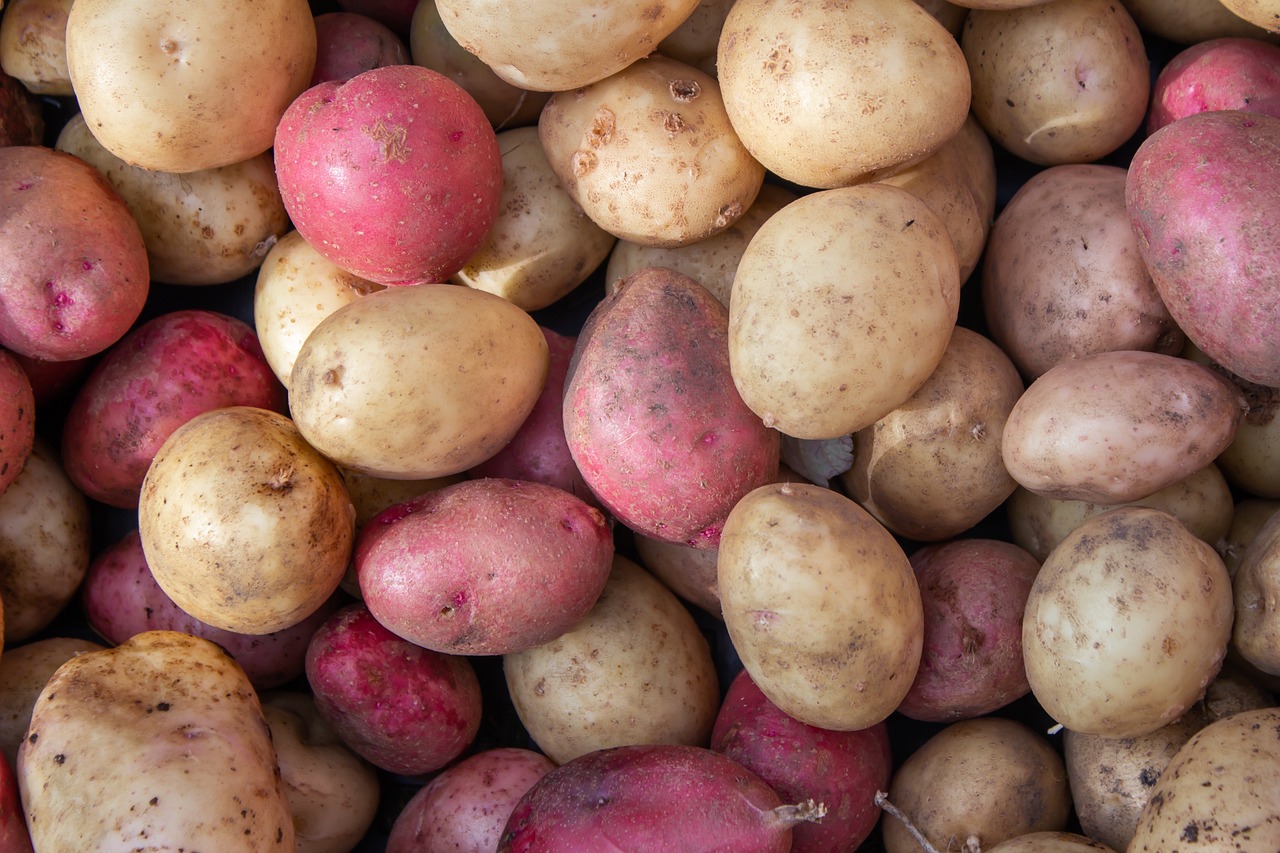Growing your own potatoes is a rewarding experience that provides fresh, tasty produce straight from your garden or allotment. Whether you have ample space or are using containers in a smaller area, planting potatoes is easier than you might think. This guide will walk you through each step, from selecting the right seed potatoes to harvesting your crop.
What Are Seed Potatoes?
Seed potatoes are specially grown tubers meant for planting, not eating. Unlike potatoes from the supermarket, seed potatoes are certified disease-free. This certification ensures you won’t introduce harmful pests or diseases into your garden or allotment. Starting with quality seed potatoes leads to healthier plants and a better harvest.
Why Avoid Planting Shop-Bought Potatoes?
While it might be tempting to plant sprouting potatoes from the shop, it’s best to avoid this. Shop-bought potatoes can carry diseases like blight or scab, which can infect your soil for years. They may also have been treated to prevent sprouting, making them unsuitable for planting. By using certified seed potatoes, you protect your garden’s health and improve your chances of a successful harvest.
Types of Potatoes: First Earlies, Second Earlies, and Maincrop
Understanding the different types of potatoes helps you plan your planting and harvesting times effectively.
First Earlies
- Planting Time: Late March or early April
- Harvest: June or July (about 10 weeks after planting)
- Popular Varieties: Some popular options are Swift and Rocket
First Earlies are the quickest to grow, making them ideal if you’re eager for a fast harvest. These potatoes are small and tender, perfect for salads and boiling, giving you an early taste of the season.
Second Earlies
- Planting Time: Early to mid-April
- Harvest: July or August (around 13-15 weeks after planting)
- Popular Varieties: Common choices include Kestrel and Charlotte
Second Earlies take a bit longer to mature and are slightly larger. They’re versatile in the kitchen, suitable for boiling, roasting, or making into salads. Varieties like Kestrel are known for their strong flavour and disease resistance, while Charlotte is popular for its firm texture.
Maincrop
- Planting Time: Mid to late April
- Harvest: September onwards (after the foliage has died back)
- Popular Varieties: Often chosen varieties are Maris Piper and Desiree
Maincrop potatoes take the longest to grow but are excellent for storing over the winter. Maris Piper is famous for its all-round cooking qualities, great for roasting and mashing. Desiree offers a creamy texture and red skin, suitable for various dishes.
Getting Your Seed Potatoes Ready: Chitting
Chitting is the process of allowing seed potatoes to sprout before planting, giving them a head start.
- Select Healthy Seed Potatoes: Choose firm potatoes without any signs of disease.
- Place in Trays or Egg Cartons: Position them with the “eyes” facing upwards.
- Store in a Cool, Light Place: A temperature around 10°C (50°F) is ideal.
- Wait for Sprouts: After 4-6 weeks, strong, green sprouts about 2-3 cm long will appear.
Planting and Earthing Up
Proper planting and care are crucial for a good potato harvest.
Preparing the Soil
- Soil Type: Potatoes prefer rich, well-drained soil that’s slightly acidic.
- Adding Nutrients: Before planting, mix in well-rotted manure or compost to boost soil fertility.
Planting Your Potatoes
- Depth and Spacing:
- First and Second Earlies: Plant 15 cm deep, spacing 30 cm between potatoes and 60 cm between rows.
- Maincrop: Plant 15 cm deep, spacing 37 cm between potatoes and 75 cm between rows.
Earthing Up

As the potato plants grow to about 20 cm tall, pile soil around the stems to form a mound. This protects developing potatoes from sunlight, which can turn them green and unsafe to eat, and encourages more tubers to form.
Watering and Mulching
- Watering: Keep the soil consistently moist, especially during flowering when potatoes are forming. Aim for about 2.5 cm (1 inch) of water per week.
- Mulching: Apply a layer of organic mulch like straw or grass clippings to retain moisture and suppress weeds.
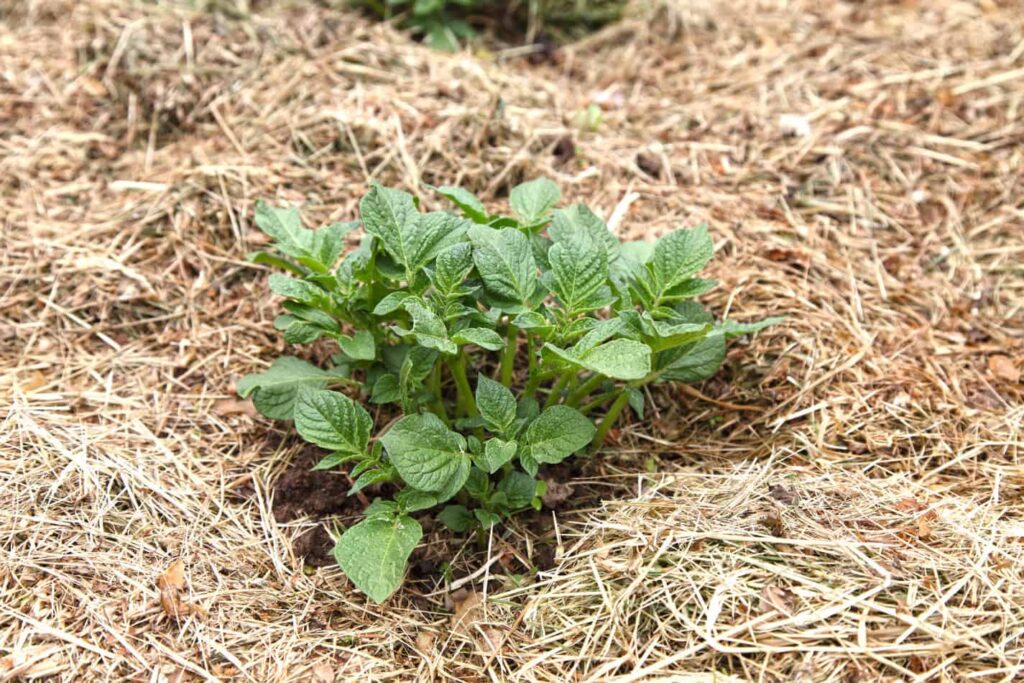
Common Pests and Diseases
Being aware of potential problems helps you take steps to prevent them.
Blight
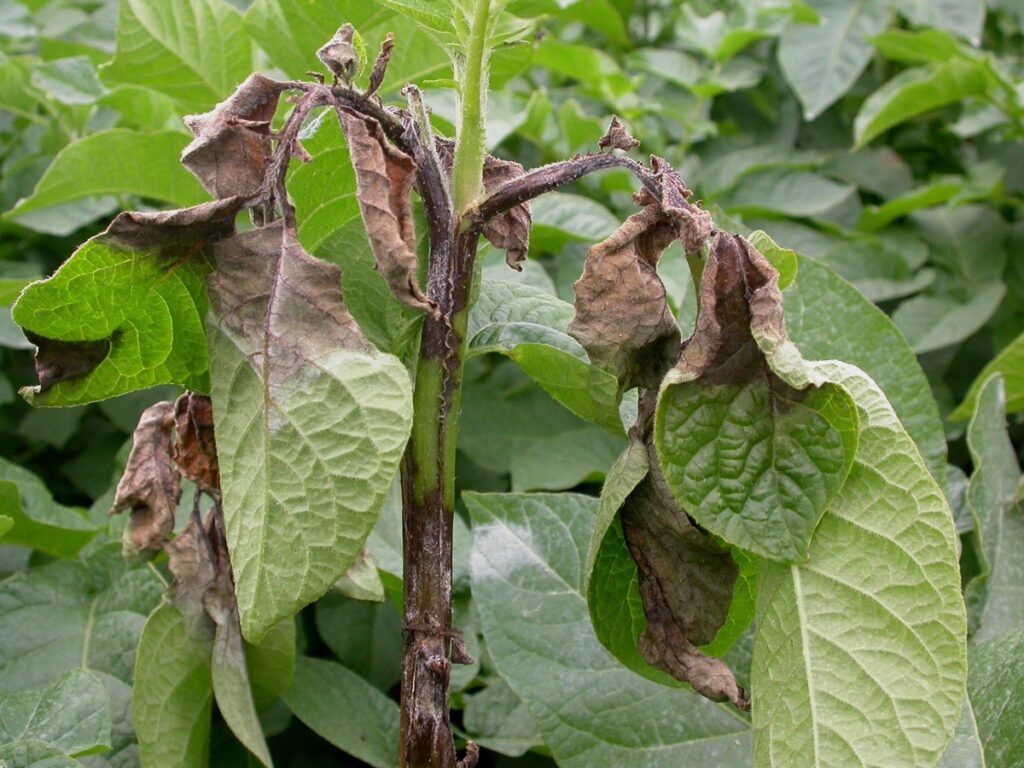
What it looks like: Brown or black spots appear on the leaves, starting as small, irregular lesions that spread rapidly. The leaves shrivel, and the plant may collapse entirely. Stems can develop dark brown lesions, and infected tubers will show sunken, dark areas with a reddish-brown rot under the skin.
What causes it: Late blight is caused by the airborne spores of Phytophthora infestans, which thrive in warm, wet weather. Spores spread quickly through the air and are washed down into the soil by rain, where they can infect tubers, leading to rot.
Are blighted potatoes safe to eat? Potatoes infected by late blight are not safe to eat, especially if the tubers show signs of rot. The blight can lead to secondary bacterial infections, causing the potatoes to decay from the inside out.
How to prevent it:
- Plant blight-resistant varieties like ‘Sarpo Mira’ or ‘Setanta.’
- Ensure good air circulation around plants to prevent moisture from lingering on the leaves.
- Water early in the morning and avoid wetting the foliage.
- Rotate crops and avoid planting potatoes in the same spot year after year.
- If blight strikes, remove and destroy infected plants immediately to prevent the spread of spores.
With proper prevention measures, you can reduce the chances of blight devastating your crop
Potato Scab
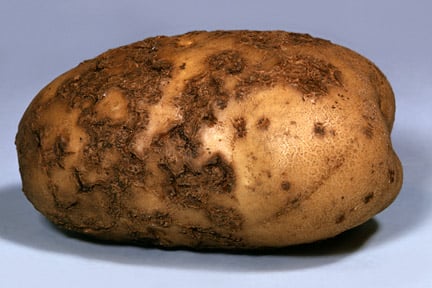
What it looks like: Rough, scabby patches on the skin of your potatoes.
What causes it: Potato scab is caused by Streptomyces bacteria, which thrive in dry, alkaline soils (with a pH above 5.5). The bacteria are more likely to infect your potatoes if the soil dries out or they don’t get regular water during the early stages of tuber growth.
Are scabby potatoes safe to eat? Yes, potatoes with scab are perfectly safe to eat. The scabs only affect the skin’s appearance and texture, not the potato’s taste or safety. You can peel or cut away the scabby parts before cooking.
How to prevent it:
- Keep your soil slightly acidic (aim for a pH between 5.0 and 5.5) to make it harder for the bacteria to thrive.
- Water your potatoes regularly, especially in the first 2-6 weeks after the tubers start growing, to reduce stress.
- Don’t use fresh manure, as it raises the pH and creates an ideal environment for the bacteria.
By managing your soil and watering properly, you can reduce the risk of scab affecting your potatoes while still being able to enjoy them if scab does occur!
Wireworms
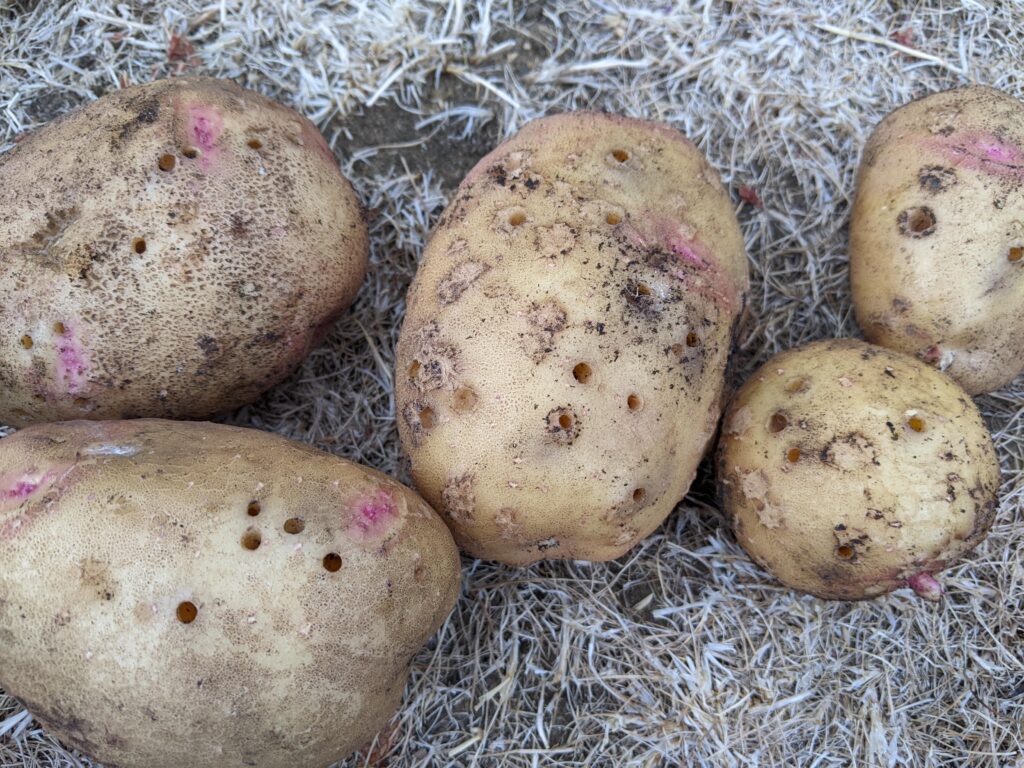
What it looks like: Small holes in the potatoes, caused by the tunneling larvae of click beetles (species Agriotes lineatus, Agriotes obscurus, and Agriotes sputator). These larvae, known as wireworms, are thin, yellow-brown, and can grow up to 25mm long.
What causes it: Wireworms thrive in soil that was previously grassland or has grassy margins. The click beetles lay their eggs in these areas, and the larvae feed on potato tubers, leaving holes as they burrow through.
Are pots a solution? Yes, growing potatoes in pots using fresh potting soil can greatly reduce the risk of wireworm damage. Since wireworms are soil-dwelling pests, avoiding infested ground by growing in containers gives you a controlled environment free from these pests
How to prevent it:
- Rotate crops to avoid planting potatoes in areas that were recently grassland or have grassy margins.
- Grow in pots to eliminate wireworms from the equation by using clean, fresh soil.
- Use traps by burying potato pieces in the soil to attract and remove wireworms.
- Expose the soil to natural predators like birds, and cultivate regularly to reduce larvae populations.
By rotating crops, using traps, and growing in pots, you can minimize wireworm damage to your potato crops
Growing Potatoes in Containers
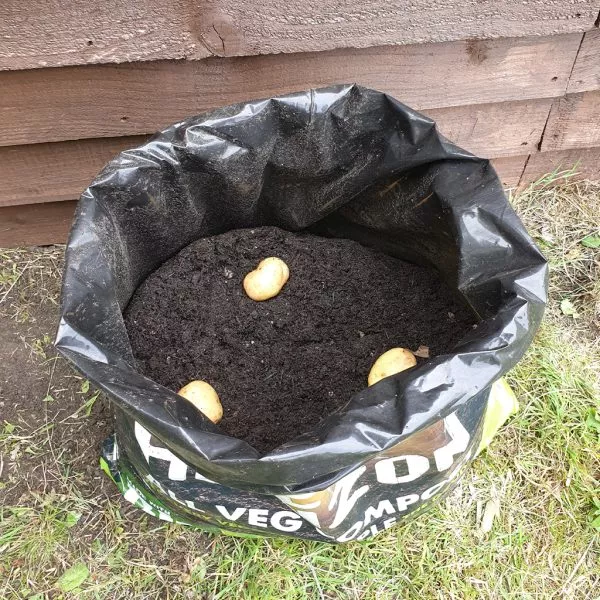
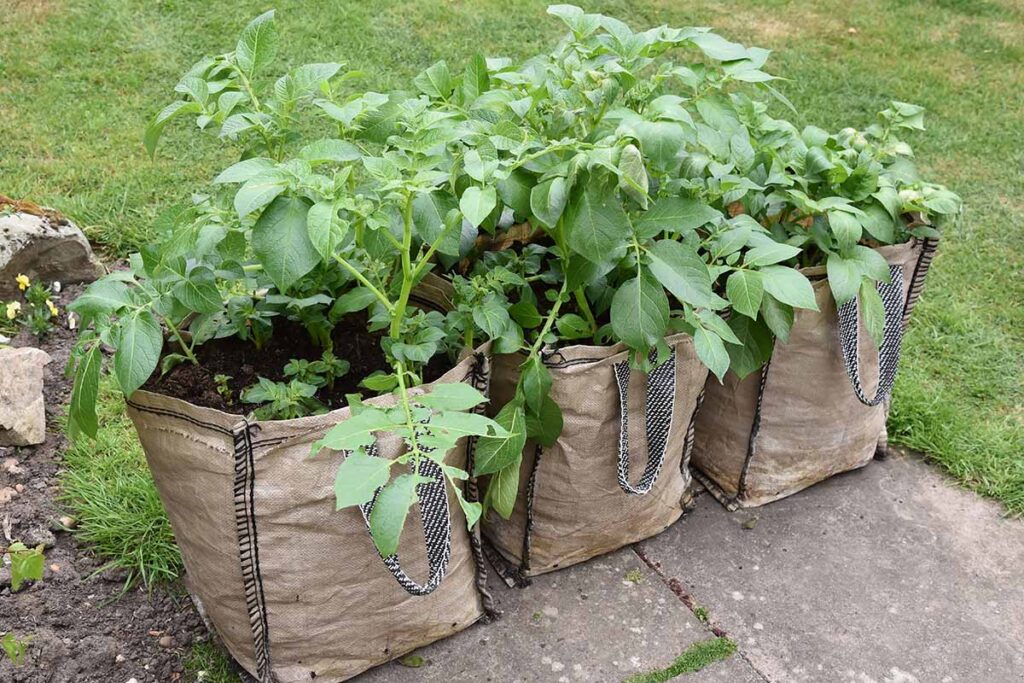
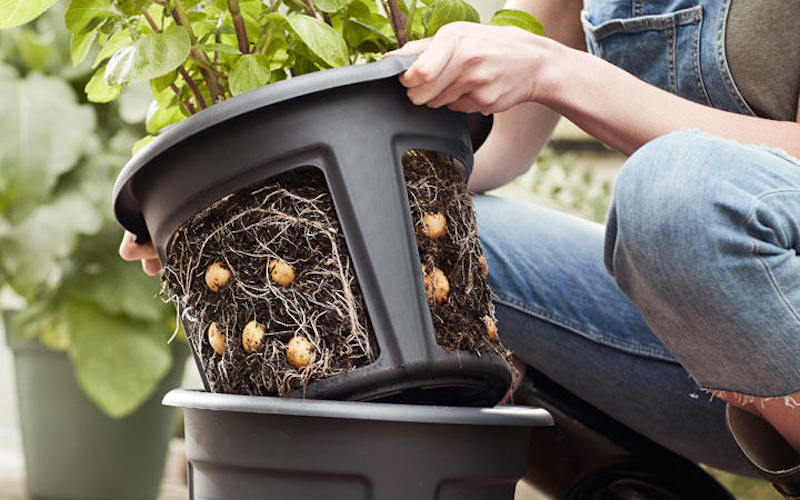
If space is limited, you can successfully grow potatoes in pots or bags.
- Choosing a Container: Use one that’s at least 30cm wide.
- Planting Steps:
- Add 10 cm of soil to the bottom.
- Place 2 or 3 seed potatoes on top depending on pot or bag size.
- Cover with another 10 cm of soil.
- Mounding Up: As plants grow, continue adding soil until the container is full.
Feeding Your Potatoes
- Fertilising: During the growing season, use a fertiliser high in potassium, like a special potato feed, to promote healthy tuber development.
I personally like to add my fertiliser at the time of sowing my potatoes my current favourite is VITAX Organic Potato Fertiliser which can be picked up on amazon.
Harvesting Your Potatoes
Knowing when to harvest ensures you get the best from your plants.
First Earlies
- When: About 10 weeks after planting, when flowers open or buds drop.
- How: Gently dig around the plant to lift the potatoes without damaging them.
- Storage: Best eaten soon after harvesting; they don’t store well.
Looking to grow First Earlies? Discover all our First Early varieties and start your potato growing journey today! See First Earlies
Second Earlies
- When: 13-15 weeks after planting.
- How: Similar to First Earlies.
- Storage: Can be stored for a short time in a cool, dark place.
Looking to grow Second Earlies? Discover all our Second Early seed potatoes at Grown Local and continue your potato growing journey today! See Second Early Seed Potatoes at Grown Local
Maincrop
- When: After the foliage has died back, usually from September onwards.
- How: Cut back the dead foliage and wait two weeks before digging up the potatoes to let the skins harden.
- Storage: Ideal for long-term storage; keep them in cloth sacks in a cool, dark place.
Looking to grow Maincrop varieties? Discover all our Maincrop seed potatoes at Grown Local and complete your potato growing journey today! See Maincrop Seed Potatoes at Grown Local
Tips for a Successful Potato Crop
- Crop Rotation: Avoid planting potatoes in the same spot each year to reduce the risk of diseases.
- Regular Checks: Inspect plants regularly for signs of pests or diseases.
- Soil Testing: Ensure the soil pH is suitable and adjust if necessary.
A Note About Our Seed Potatoes
At Grown Local, we offer premium-quality seed potatoes grown in Perth, Scotland. Scotland is renowned for producing some of the finest agricultural products, and our seed potatoes are no exception. Our seed potatoes are:
- Certified Disease-Free: Providing a healthy start for your garden or allotment.
- High-Quality Varieties: Selected for excellent taste, good yields, and resistance to diseases.
- Expertly Grown: Raised under ideal conditions for the best possible results.
Order your seed potatoes now for delivery in late January and begin your potato-growing journey with confidence.
Ready to start planting? Visit Grown Local Seed Potatoes to explore our range of premium seed potatoes and gardening supplies.

